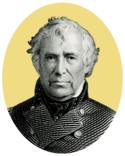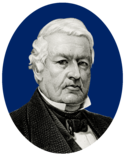1848 Whig National Convention
| 1848 presidential election | |
  Nominees Taylor and Fillmore | |
| Convention | |
|---|---|
| Date(s) | June 7–9, 1848 |
| City | Philadelphia, Pennsylvania |
| Venue | Chinese Museum Building |
| Candidates | |
| Presidential nominee | Zachary Taylor of Louisiana |
| Vice-presidential nominee | Millard Fillmore of New York |
| Voting | |
| Total delegates | 280 |
| Votes needed for nomination | 140 |
| Results (president) | Taylor (LA): 171 (61.07%) Scott (NY): 63 (22.5%) Clay (KY): 32 (11.43%) Webster (MA): 14 (5%) |
| Ballots | 4 |
The 1848 Whig National Convention was a presidential nominating convention held from June 7 to 9 in Philadelphia. It nominated the Whig Party's candidates for president and vice president in the 1848 election. The convention selected General Zachary Taylor of Louisiana for president and former Representative Millard Fillmore of New York for vice president.
Taylor and General Winfield Scott had both emerged as contenders for the Whig presidential nomination after serving in the Mexican–American War, while two long-time party leaders, Senator Henry Clay of Kentucky and Senator Daniel Webster of Massachusetts, also commanded support in the party. With Southern delegates united around his candidacy, Taylor took the lead on the first ballot. Clay finished a strong second to Taylor on the first ballot of the convention, but his support faded on subsequent ballots and Taylor took the nomination on the fourth ballot.
After Webster declined the vice presidential nomination, Fillmore and businessman Abbott Lawrence of Massachusetts emerged as the top choices for vice president. Fillmore clinched the nomination on the second ballot. The Whig ticket went on to win the 1848 presidential election, defeating the Democratic ticket of Lewis Cass and William O. Butler.
The Convention


The convention was held from June 7 to 9 in Philadelphia, Pennsylvania. Every state was represented except for Texas. It was chaired by John A. Collier and John M. Morehead. Taylor had been courted by both the Democrats and the Whigs, but ultimately declared himself a Whig. The platform adopted largely consisted of praise for Taylor, with less attention paid to specific policies.[1]
The venue for the convention was the Chinese Museum Building. The building since was destroyed by fire in 1854.[2]
There were 280 individuals seated as delegates to the convention.[2]
Presidential nomination
By 1847, General Zachary Taylor had emerged as a contender for the Whig nomination in the 1848 presidential election.[3] Despite Taylor's largely unknown political views, many Whigs believed he was the party's strongest possible candidate due to his martial accomplishments in the Mexican–American War.[4] Henry Clay initially told his allies that he would not run in the 1848 presidential election, but he was unwilling to support Taylor, a "mere military man.".[5] Although Daniel Webster and General Winfield Scott each commanded a limited base of support in the party, Taylor and Clay each saw the other as their lone serious rival for the Whig nomination.[6]
Taylor led on the first ballot and grew his lead on subsequent ballots. On the fourth ballot, he secured 171 votes and won the presidential nomination.
Candidates
-
General Zachary Taylor of Louisiana
-
Former Senator Henry Clay of Kentucky
-
General Winfield Scott of New York
-
Senator Daniel Webster of Massachusetts
-
Senator John M. Clayton of Delaware
-
Associate Justice John McLean of Ohio
| Presidential Ballot | |||||||||||||||||||||||||||
| Ballot | 1st | 2nd | 3rd | 4th | |||||||||||||||||||||||
|---|---|---|---|---|---|---|---|---|---|---|---|---|---|---|---|---|---|---|---|---|---|---|---|---|---|---|---|
| Taylor | 111 | 118 | 133 | 171 | |||||||||||||||||||||||
| Clay | 97 | 86 | 74 | 32 | |||||||||||||||||||||||
| Scott | 43 | 49 | 54 | 63 | |||||||||||||||||||||||
| Webster | 22 | 22 | 17 | 14 | |||||||||||||||||||||||
| Clayton | 4 | 4 | 1 | 0 | |||||||||||||||||||||||
| McLean | 2 | 0 | 0 | 0 | |||||||||||||||||||||||
| Blanks | 11 | 11 | 11 | 10 | |||||||||||||||||||||||
-
1st Presidential Ballot
-
2nd Presidential Ballot
-
3rd Presidential Ballot
-
4th Presidential Ballot
Vice Presidential nomination
Vice Presidential candidates
Whig Party leader Thurlow Weed hoped to secure the vice presidency for former New York governor William H. Seward, a vocal opponent of slavery, or to have him appointed U.S. Secretary of State.[7] New Yorkers opposed to Seward promoted Millard Fillmore, the New York State Comptroller, for vice president; under the conventions of the time, two top positions could not go to individuals from the same state.[8] Former congressman Solomon Foot of Vermont went to the convention as a supporter of Abbott Lawrence for vice president.[9] As a key Taylor supporter, Lawrence expected to be nominated for vice president.[10] Northern anti-slavery delegates perceived Lawrence as more accepting of slavery than Fillmore.[10] Recognizing that the Whigs would likely collapse if Lawrence was nominated and the northern anti-slavery delegates left the party, or if southern delegates left following a Seward nomination, Foot agreed to shift his support to Fillmore.[8][10] Lawrence's support eroded as other northern delegates followed Foot's lead, and on the first ballot, Fillmore had 115 votes and Lawrence 109.[8][10] (Seward was subsequently elected to the U.S. Senate for the term starting in March 1849.)[11]
Withdrawn
Declined
Balloting
Webster was offered the vice presidential spot on the ticket, but declined. Former New York Representative Millard Fillmore was chosen as the vice presidential candidate on the second ballot.
| Ballots | 1 | 2 |
|---|---|---|
| Millard Fillmore | 115 | 173 |
| Abbott Lawrence | 109 | 87 |
| Not Voting | 16 | 24 |
| Andrew Stewart | 14 | 0 |
| Thomas M.T. McKennan | 13 | 0 |
| George Evans | 6 | 2 |
| John Sergeant | 6 | 1 |
| John M. Clayton | 3 | 3 |
| Hamilton Fish | 2 | 0 |
| Thomas Ewing Sr. | 1 | 0 |
| Thomas B. King | 1 | 0 |
| John Young | 1 | 0 |
| Rufus Choate | 1 | 0 |
| Solomon Foot | 1 | 0 |
| George Lunt | 1 | 0 |
-
1st Vice Presidential Ballot
-
2nd Vice Presidential Ballot
See also
- U.S. presidential nomination convention
- 1848 United States presidential election
- 1848 Democratic National Convention
References
- ^ Havel, James T. (1996). U.S. Presidential Elections and the Candidates: A Biographical and Historical Guide. Vol. 2: The Elections, 1789–1992. New York: Simon & Schuster. p. 24. ISBN 0-02-864623-1.
- ^ a b "1848 Whig National Convention". data.philly.com. Philly.com. Retrieved 17 July 2022.
- ^ Klotter 2018, pp. 337–338.
- ^ Heidler & Heidler 2010, pp. 420–421.
- ^ Klotter 2018, pp. 342–345.
- ^ Klotter 2018, pp. 345–346.
- ^ Brinkley, Alan; Dyer, Davis (2004). The American Presidency. New York, NY: Houghton Mifflin. p. 146. ISBN 978-0-6183-8273-6 – via Google Books.
- ^ a b c Brinkley, Dyer, p. 146.
- ^ Holt, Michael F. (2003). The Rise and Fall of the American Whig Party. New York, NY: Oxford University Press. pp. 327–329. ISBN 978-0-1951-6104-5 – via Google Books.
- ^ a b c d Holt, pp. 327–329.
- ^ Hoffer, Peter Charles (2022). Seward's Law: Country Lawyering, Relational Rights, and Slavery. Ithaca, NY: Cornell University Press. pp. 60–61. ISBN 978-1-5017-6734-0 – via Google Books.
Bibliography
- Heidler, David S.; Heidler, Jeanne T. (2010). Henry Clay: The Essential American. Random House. ISBN 978-1-58836-995-6.
- Holt, Michael F. (1999). The Rise and Fall of the American Whig Party: Jacksonian Politics and the Onset of the Civil War. Oxford University Press. ISBN 0-19-505544-6.
- Klotter, James C. (2018). Henry Clay: The Man Who Would Be President. Oxford University Press. ISBN 9780190498047.
Primary sources
- Chester, Edward W A guide to political platforms (1977) online
- Porter, Kirk H. and Donald Bruce Johnson, eds. National party platforms, 1840-1964 (1965) online 1840-1956
External links
- <http://www.ourcampaigns.com/RaceDetail.html?RaceID=58512> Accessed: June 11, 2016

























